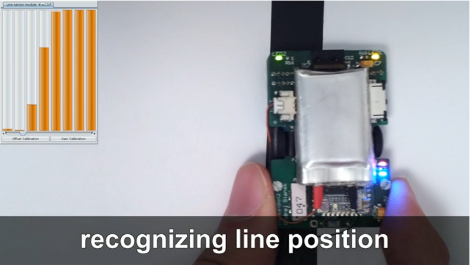
This tiny line-following robot is quite impressive. It’s [Ondrej Stanek’s] second take on the design, which he calls PocketBot 2. Just like the earlier version, this robot is small enough to fit in a matchbox, but it’s received several upgrades in this iteration.
The coin cells that ran the previous version have been replaced by a rechargeable Lithium Ion cell. The ATmega8 which controlled the first robot has been swapped out for an ATmega128 running at 32 MHz. You won’t find an IR receiver on this one either, it’s been traded for a Bluetooth module which adds a quantum leap in functionality. For instance, the graph in the upper left of this photograph shows the reflective sensor data readings used to follow the line.
There’s all kinds of great engineering in this design, which is shown off in the video after the break. One of our favorite parts is that the axles are attracted to the center of the robot by one rare-earth magnet. This keeps the rubber tires pressed against the motor spindles rather than use a gearing system.
[vimeo http://vimeo.com/32406001 w=470]
















very cool little bot, great construction and presentation. Gold medal well deserved :D
only thing it is missing are some tiny infrared sensors… if it had them, then it would be the perfect little bot.
oops didnt get to that part in the vid.
Wow.. quality engineering. Love the alternative motor gearing. Very inventive.
Completely boggled!
Awesome job!
I’ll take 5 please!
Wow, the 128 is running at 2x rated frequency! The more I see AVRs in action, the more impressed I am.
lol I think you mean 1x
Hey, the summary said nothing about xmega: they reported it as a ATmega128, which is rated to 16MHz.
Yeah, I should have read the article :-)
That’s an XMega chip, not the megaAVR in the arduino. Has double memory (all parts) and a bootloader section apart from standard memory. It’s running at the right speed
Ahh, the summary is wrong, then; they said it was the ATmega128. Oh well, still very cool :-)
While this is a XMega which can run at 32Mhz. I’ve seen ATMega32 chips run at 32Mhz, they get a bit warm but seem to work.
I’m also running ATMega8 chips at 20Mhz without problems. But they might not work in the full temperature range.
I really need to learn to solder smd components…
It’s not that hard really, get yourself a hot air solder station on ebay for about $60 for the more advanced parts, and a fine tip for your temperature controlled iron for resistors and such.
Start training with 0805 size 2 terminal components and SOIC ICs and move on from there.
That’s not ATmega128, that’s ATxmega128 in a new robot.
this would be great for searching out building vents for bombs and the like. contact security companies and sell em the rights to manufacture and distribute them! you’ll be rich! (make sure that you include that it is NOT a Exclusive License or they might take advantage of it!)
Wow, that looks incredible! Very nice job! Any plans of manufacturing and selling these?
Wow!
I’m inspired! An amazing little robot!
Absolutely fantastic!
This has great potential both as a teaching toy and as a product for “serious” uses.
I’d love to buy a couple, one for me to tinker with and the other for my cat:) It just needs auto homing/recharge routines to be 100% autonomous in that context.
I am not into these line following robots but this is one well designed and built prototype!
Great work.
The design and layout (not to mention the presentation materials) are better than many professionally built robots I’ve come across. And Ondřej’s mastery of CAD (Eagle?), 3D rendering (POVRay?) and video in addition to programming and EE skills are very impressive. Hats off to his skills and the effort he put into this build.
Amazing job!
When you think there is nothing else to see, he shows another sensor somewhere in that tiny board. Brilliant results and performance for that size!
Fantastic. I love the detail the video went into.
I always wanted to make a bot but I’m a software guy and I’m not really ready to design circuits. Especially those driving motors and such.
This should be on Kickstarter!
I bet this could be made smaller. I’ve seen god damn femto-class sumo bots. 1x1x1cm, that’s just insane.
Excellent! A great trick would be to cut away the bottom of a match box and then place the robot in the box, and send it signals to srat moving around to scare people